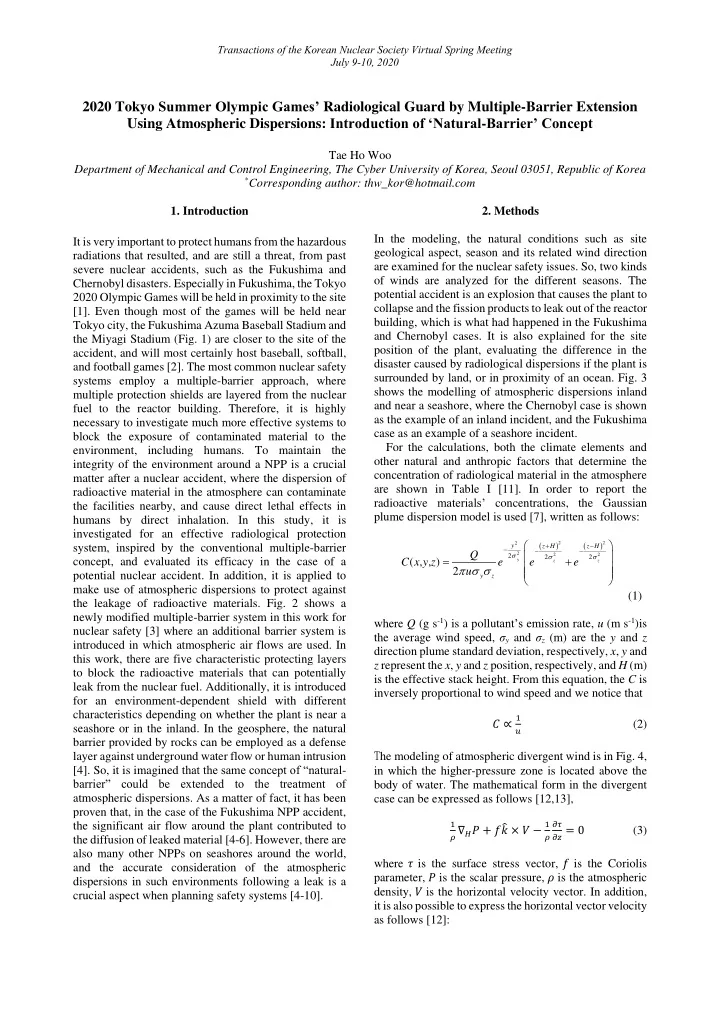

Transactions of the Korean Nuclear Society Virtual Spring Meeting July 9-10, 2020 2020 Tokyo Summer Olympic Games’ Radiological Guard by Multiple-Barrier Extension Using Atmospheric Dispersions : Introduction of ‘Natural - Barrier’ Concept Tae Ho Woo Department of Mechanical and Control Engineering, The Cyber University of Korea, Seoul 03051, Republic of Korea * Corresponding author: thw_kor@hotmail.com 1. Introduction 2. Methods In the modeling, the natural conditions such as site It is very important to protect humans from the hazardous geological aspect, season and its related wind direction radiations that resulted, and are still a threat, from past are examined for the nuclear safety issues. So, two kinds severe nuclear accidents, such as the Fukushima and of winds are analyzed for the different seasons. The Chernobyl disasters. Especially in Fukushima, the Tokyo potential accident is an explosion that causes the plant to 2020 Olympic Games will be held in proximity to the site collapse and the fission products to leak out of the reactor [1]. Even though most of the games will be held near building, which is what had happened in the Fukushima Tokyo city, the Fukushima Azuma Baseball Stadium and and Chernobyl cases. It is also explained for the site the Miyagi Stadium (Fig. 1) are closer to the site of the position of the plant, evaluating the difference in the accident, and will most certainly host baseball, softball, disaster caused by radiological dispersions if the plant is and football games [2]. The most common nuclear safety surrounded by land, or in proximity of an ocean. Fig. 3 systems employ a multiple-barrier approach, where shows the modelling of atmospheric dispersions inland multiple protection shields are layered from the nuclear and near a seashore, where the Chernobyl case is shown fuel to the reactor building. Therefore, it is highly as the example of an inland incident, and the Fukushima necessary to investigate much more effective systems to case as an example of a seashore incident. block the exposure of contaminated material to the For the calculations, both the climate elements and environment, including humans. To maintain the other natural and anthropic factors that determine the integrity of the environment around a NPP is a crucial concentration of radiological material in the atmosphere matter after a nuclear accident, where the dispersion of are shown in Table I [11]. In order to report the radioactive material in the atmosphere can contaminate radioactive materials’ concentrations, the Gaussian the facilities nearby, and cause direct lethal effects in plume dispersion model is used [7], written as follows: humans by direct inhalation. In this study, it is investigated for an effective radiological protection 2 2 2 y system, inspired by the conventional multiple-barrier z H z H Q 2 2 2 2 2 2 concept, and evaluated its efficacy in the case of a C x y z ( , , ) e y e z e z 2 u potential nuclear accident. In addition, it is applied to y z make use of atmospheric dispersions to protect against (1) the leakage of radioactive materials. Fig. 2 shows a newly modified multiple-barrier system in this work for where Q (g s -1 ) is a pollut ant’s emission rate, u (m s -1 )is nuclear safety [3] where an additional barrier system is the average wind speed, σ y and σ z (m) are the y and z introduced in which atmospheric air flows are used. In direction plume standard deviation, respectively, x , y and this work, there are five characteristic protecting layers z represent the x , y and z position, respectively, and H (m) to block the radioactive materials that can potentially is the effective stack height. From this equation, the C is leak from the nuclear fuel. Additionally, it is introduced inversely proportional to wind speed and we notice that for an environment-dependent shield with different characteristics depending on whether the plant is near a 1 𝐷 ∝ (2) seashore or in the inland. In the geosphere, the natural 𝑣 barrier provided by rocks can be employed as a defense T he modeling of atmospheric divergent wind is in Fig. 4, layer against underground water flow or human intrusion [4]. So, it is imagined that the same concept of “natural - in which the higher-pressure zone is located above the barrier” could be extended to the treatment of body of water. The mathematical form in the divergent atmospheric dispersions. As a matter of fact, it has been case can be expressed as follows [12,13], proven that, in the case of the Fukushima NPP accident, 1 1 𝜖𝜐 the significant air flow around the plant contributed to ̂ × 𝑊 − 𝜍 ∇ 𝐼 𝑄 + 𝑔𝑙 𝜖𝑨 = 0 (3) 𝜍 the diffusion of leaked material [4-6]. However, there are also many other NPPs on seashores around the world, where 𝜐 is the surface stress vector, 𝑔 is the Coriolis and the accurate consideration of the atmospheric parameter, 𝑄 is the scalar pressure, 𝜍 is the atmospheric dispersions in such environments following a leak is a density, 𝑊 is the horizontal velocity vector. In addition, crucial aspect when planning safety systems [4-10]. it is also possible to express the horizontal vector velocity as follows [12]:
Recommend
More recommend